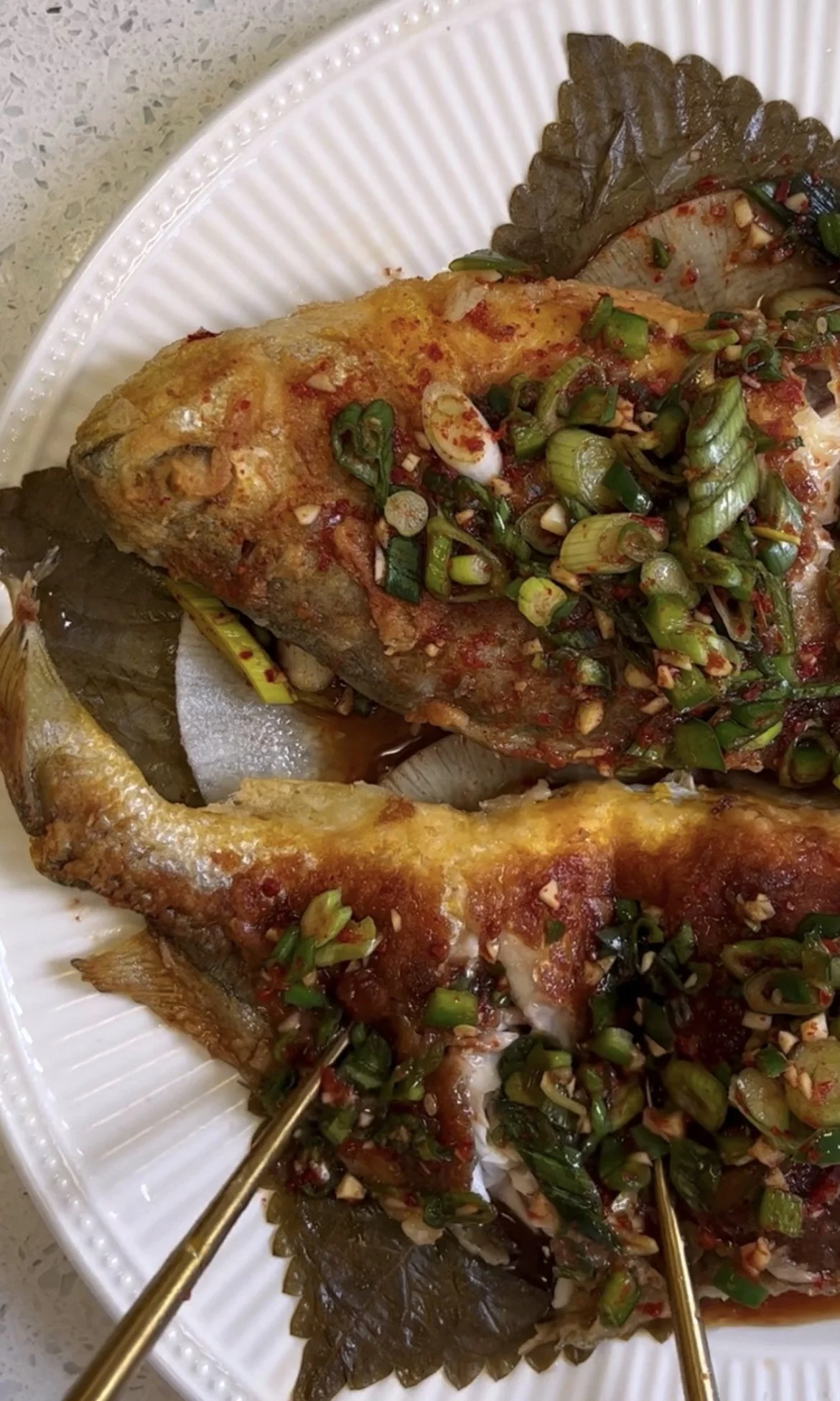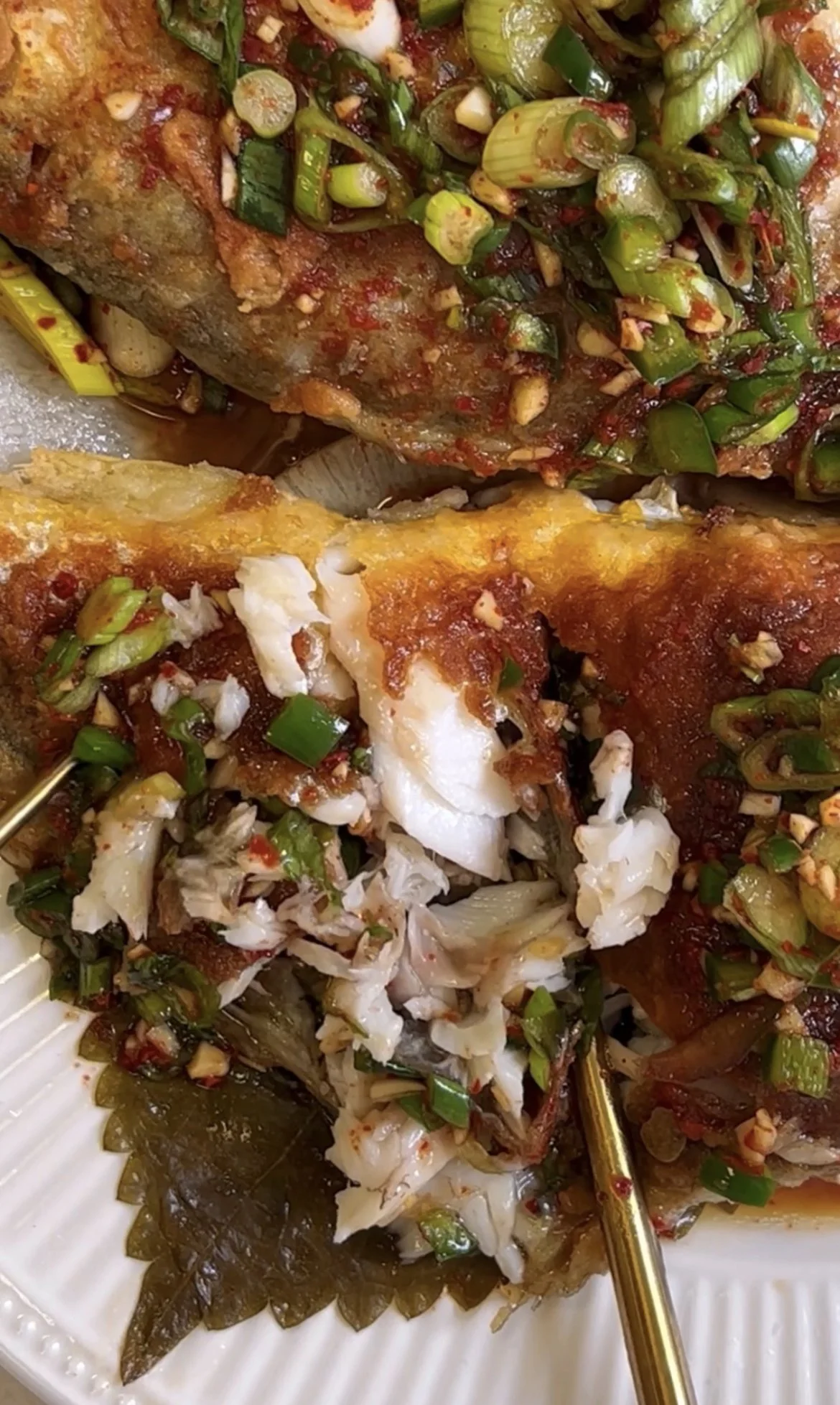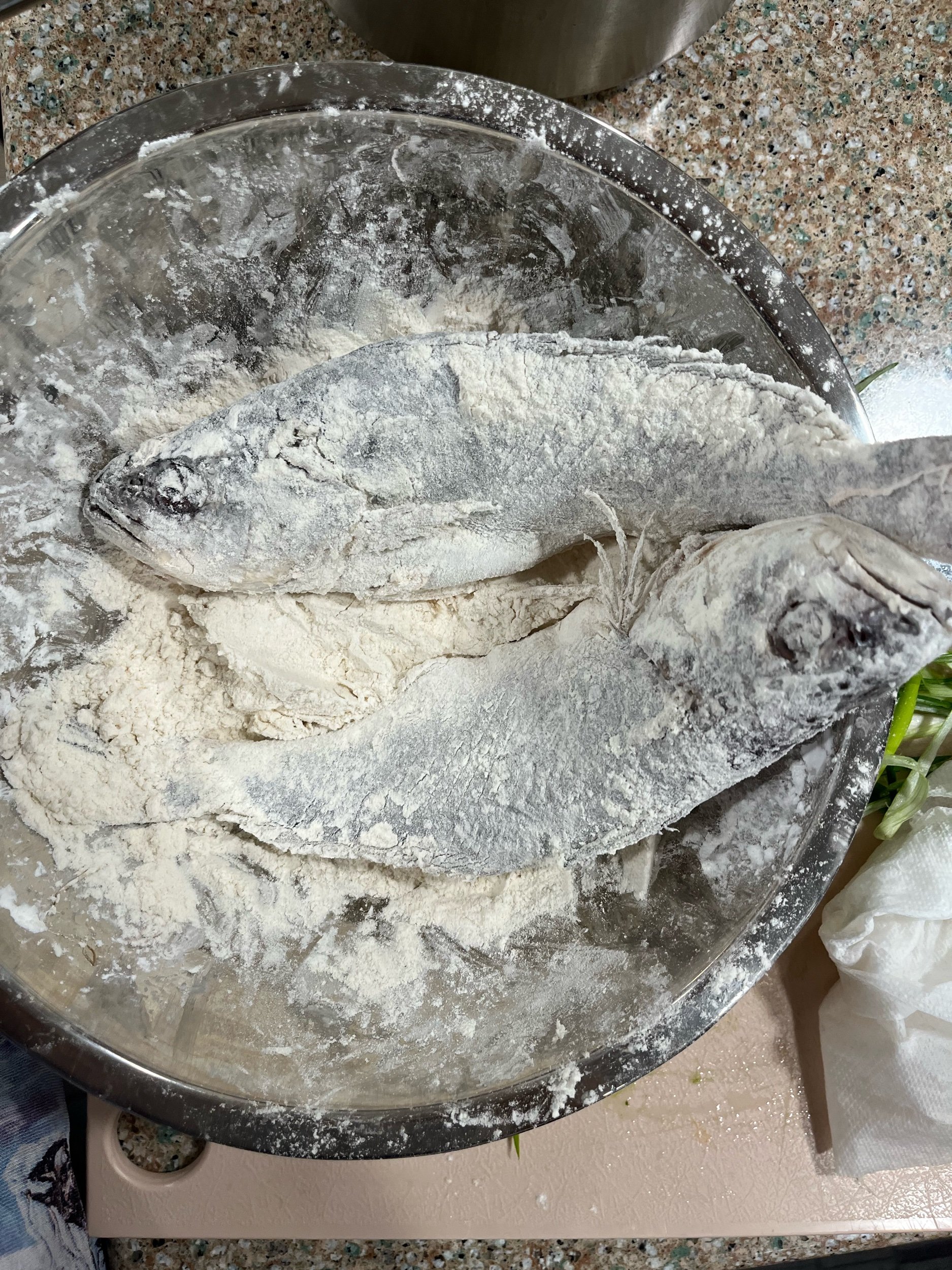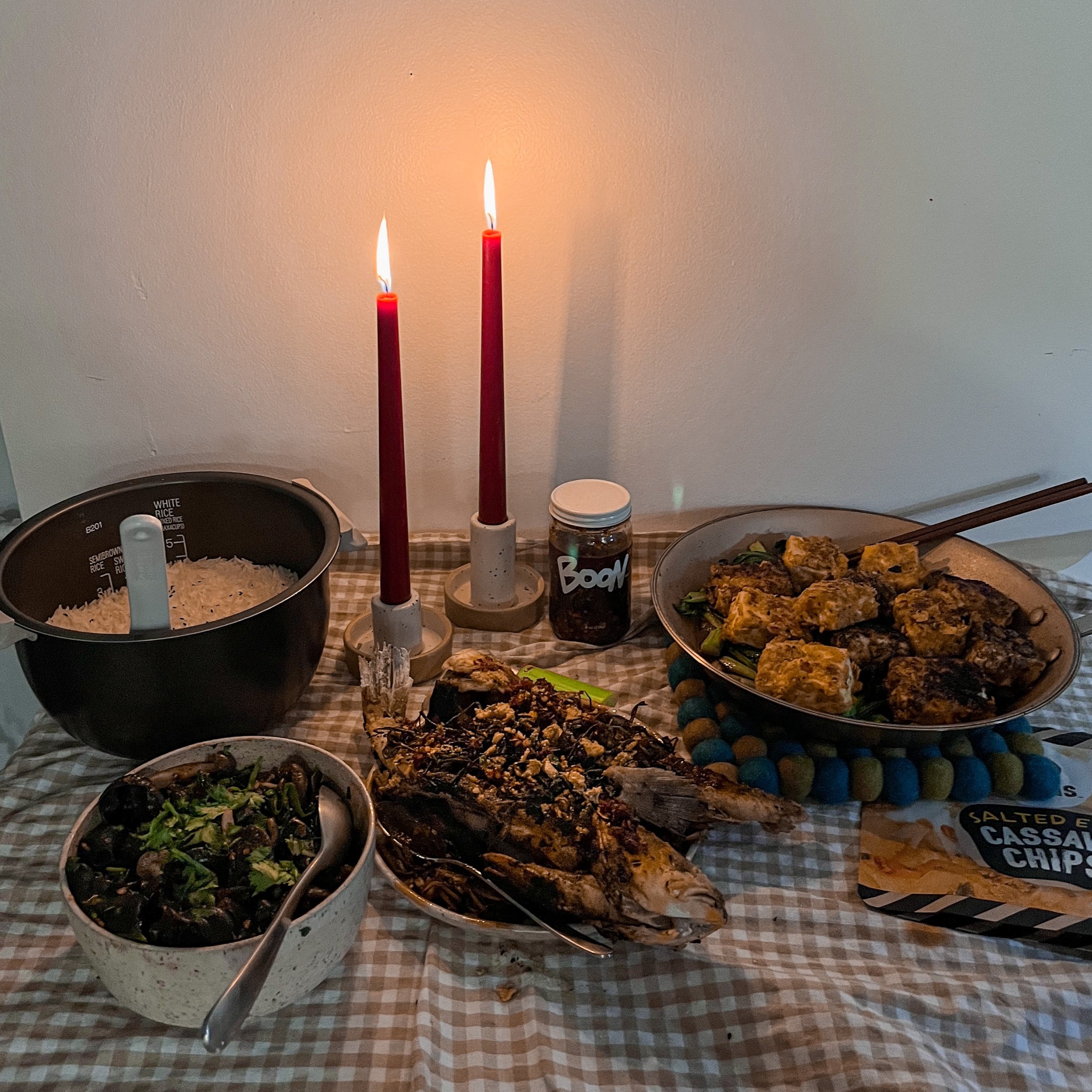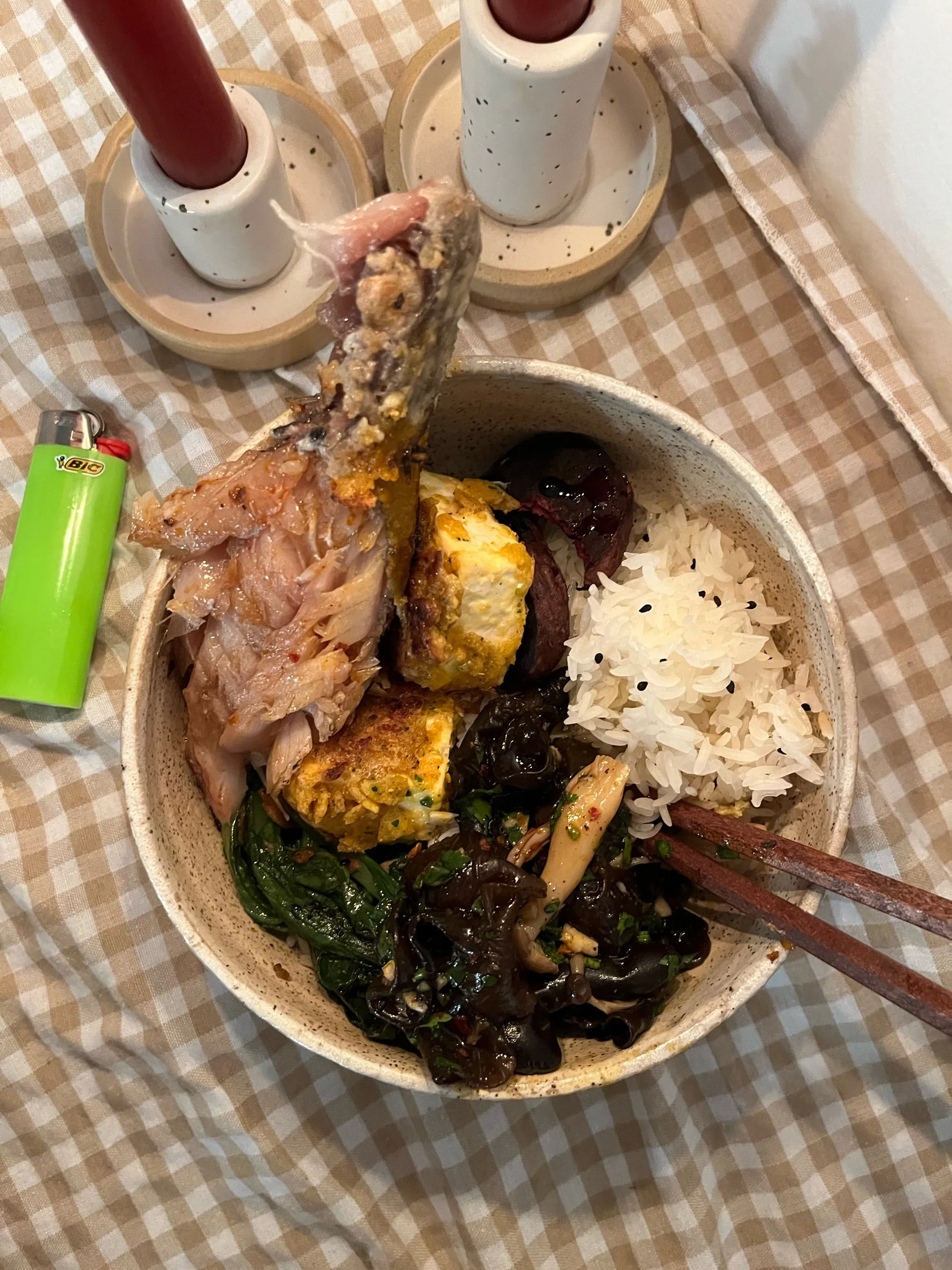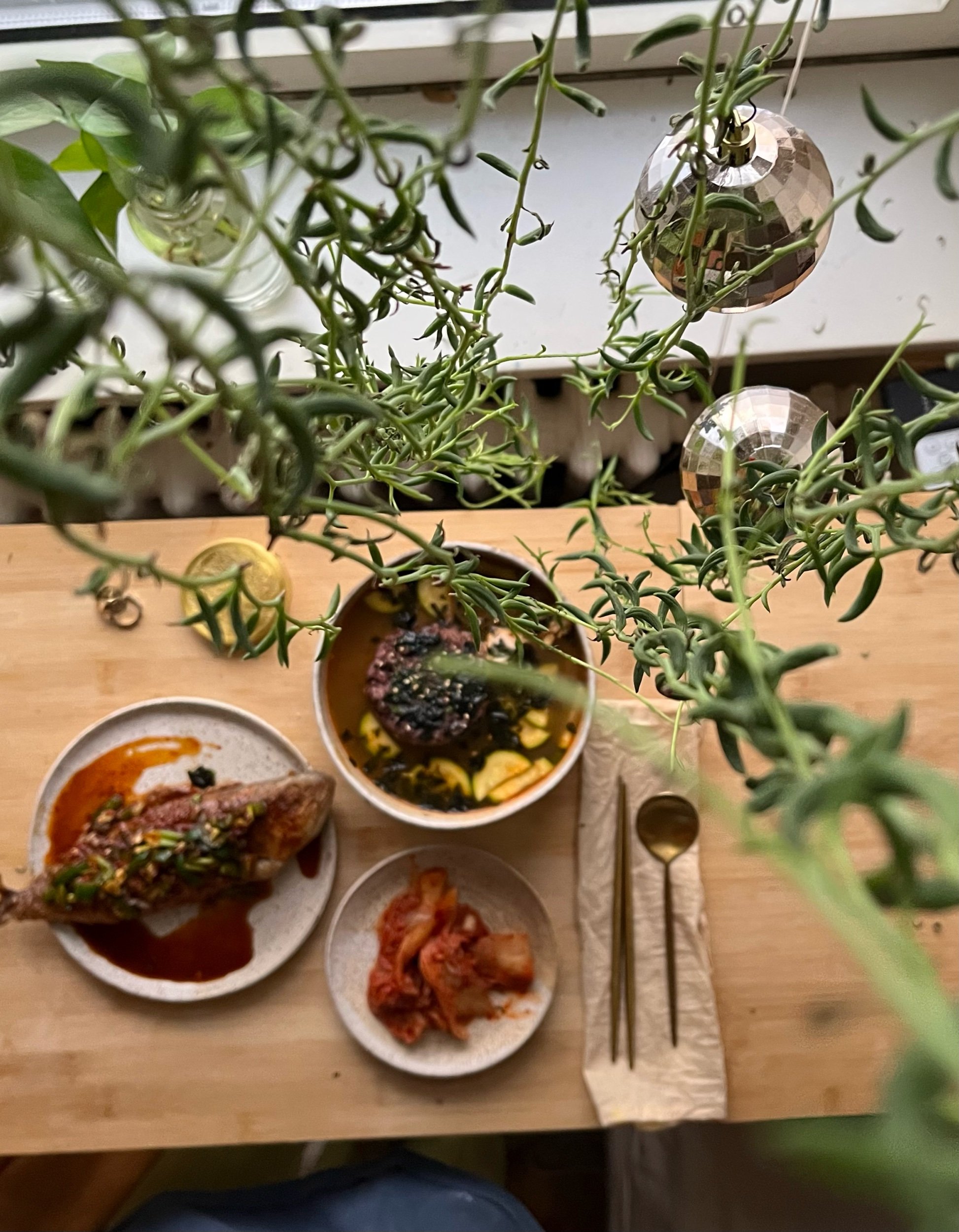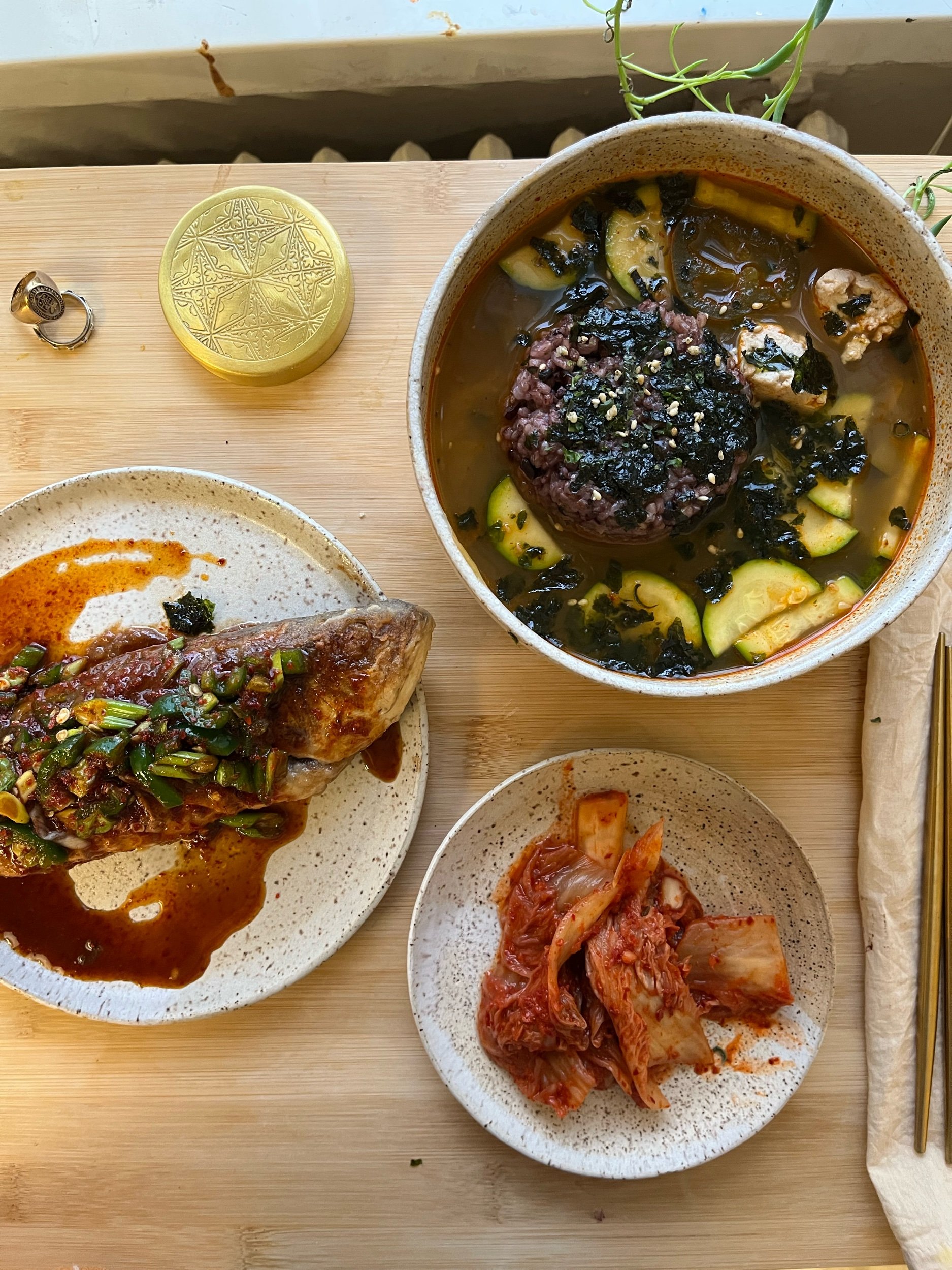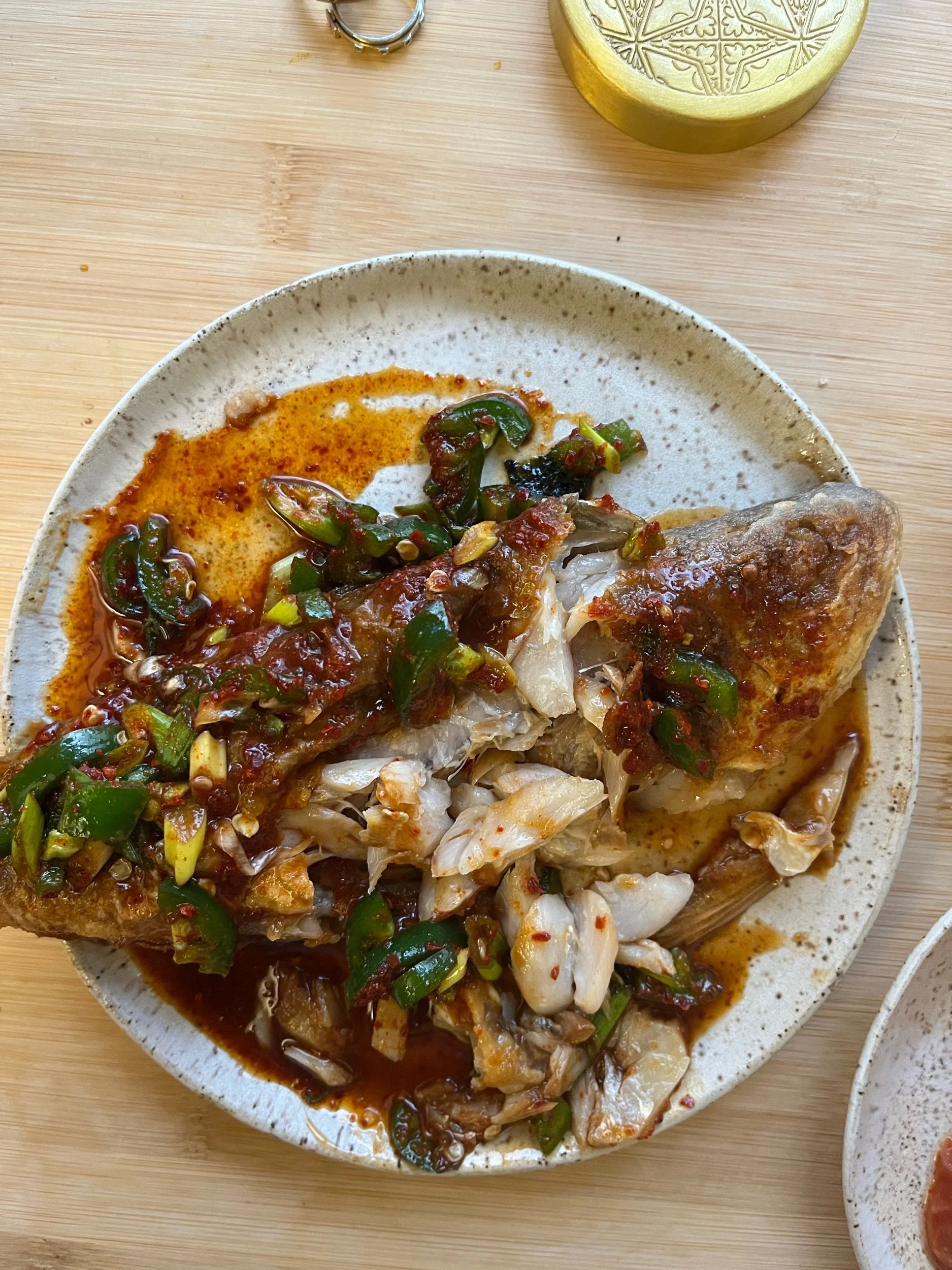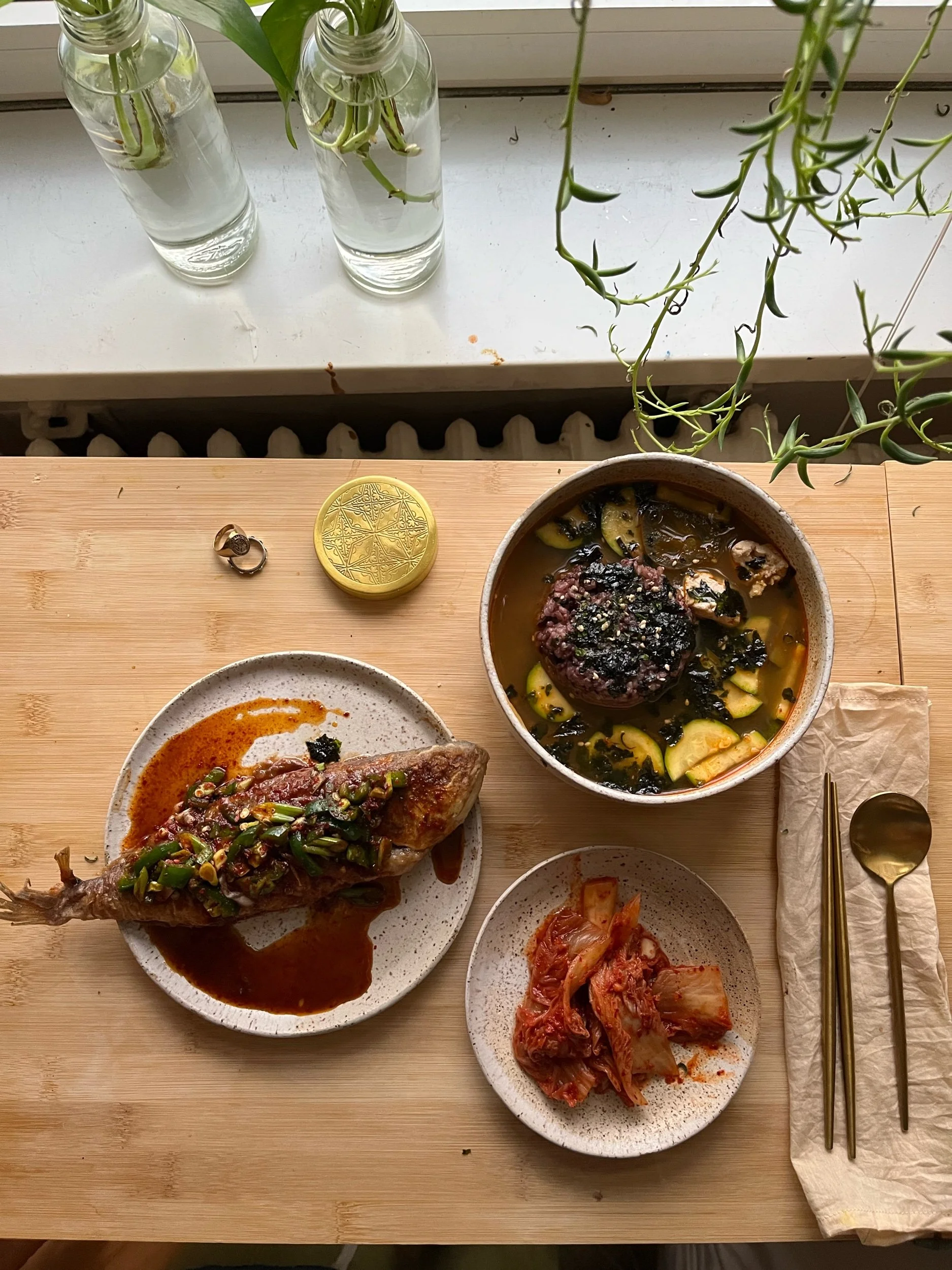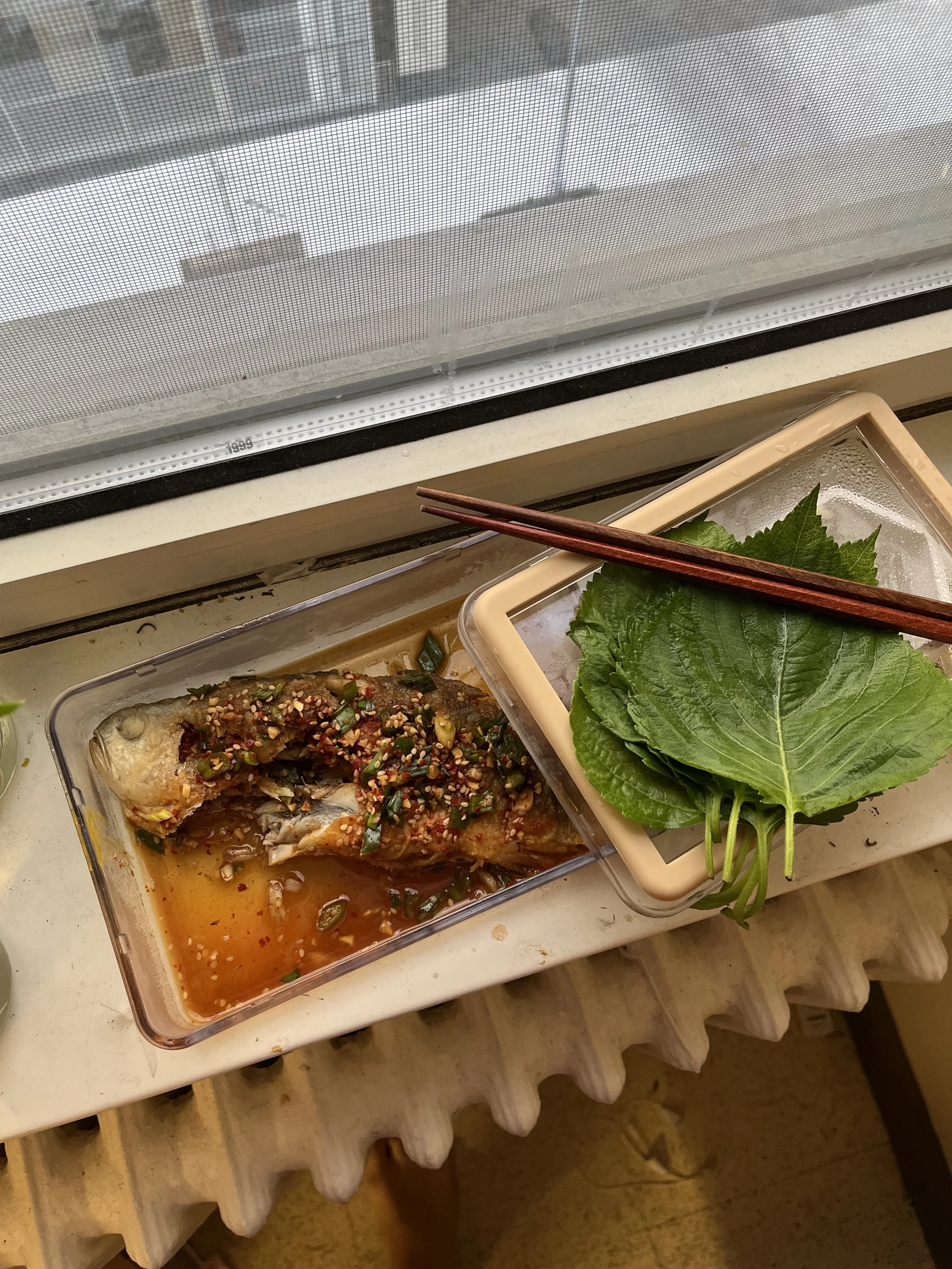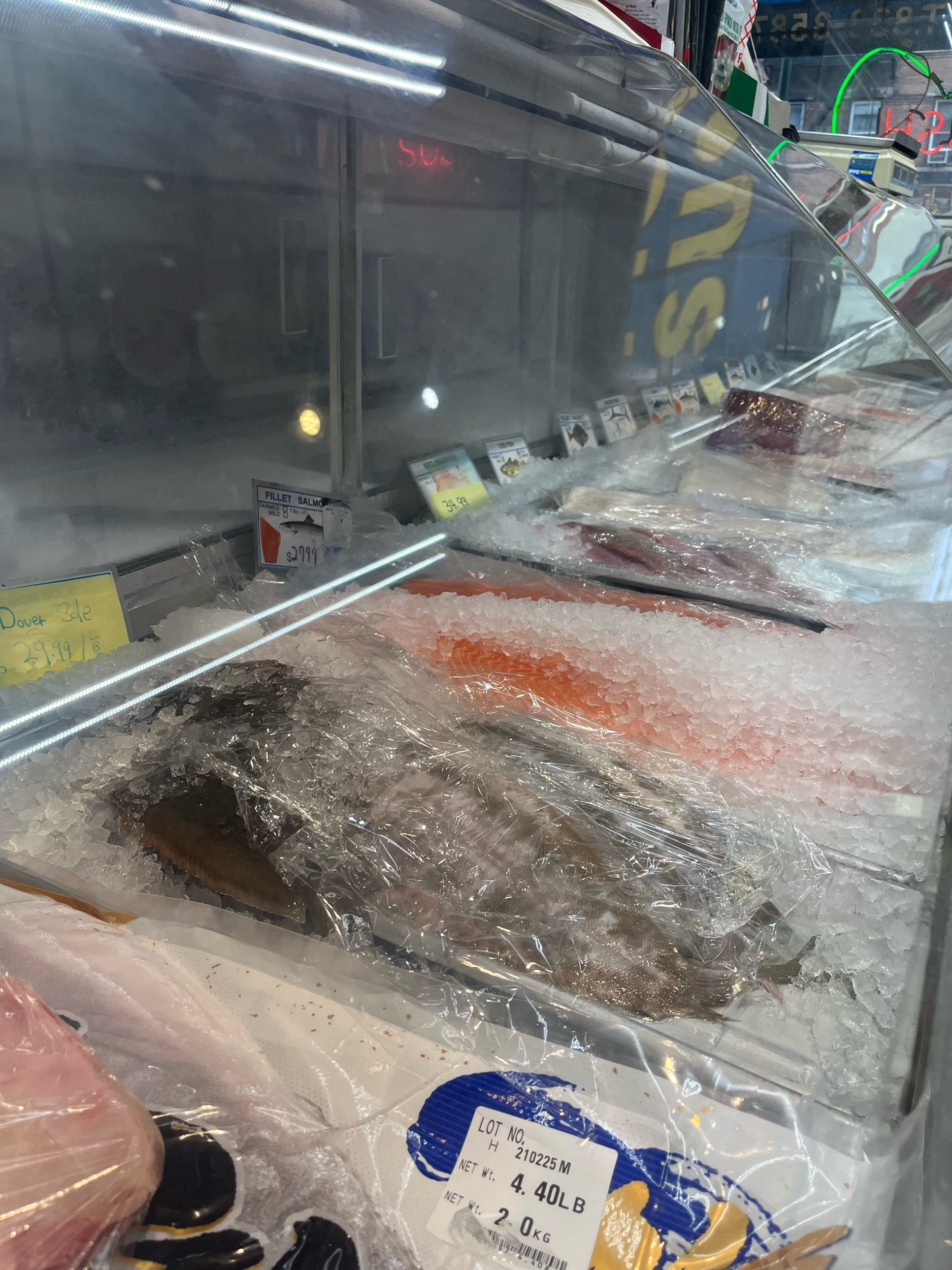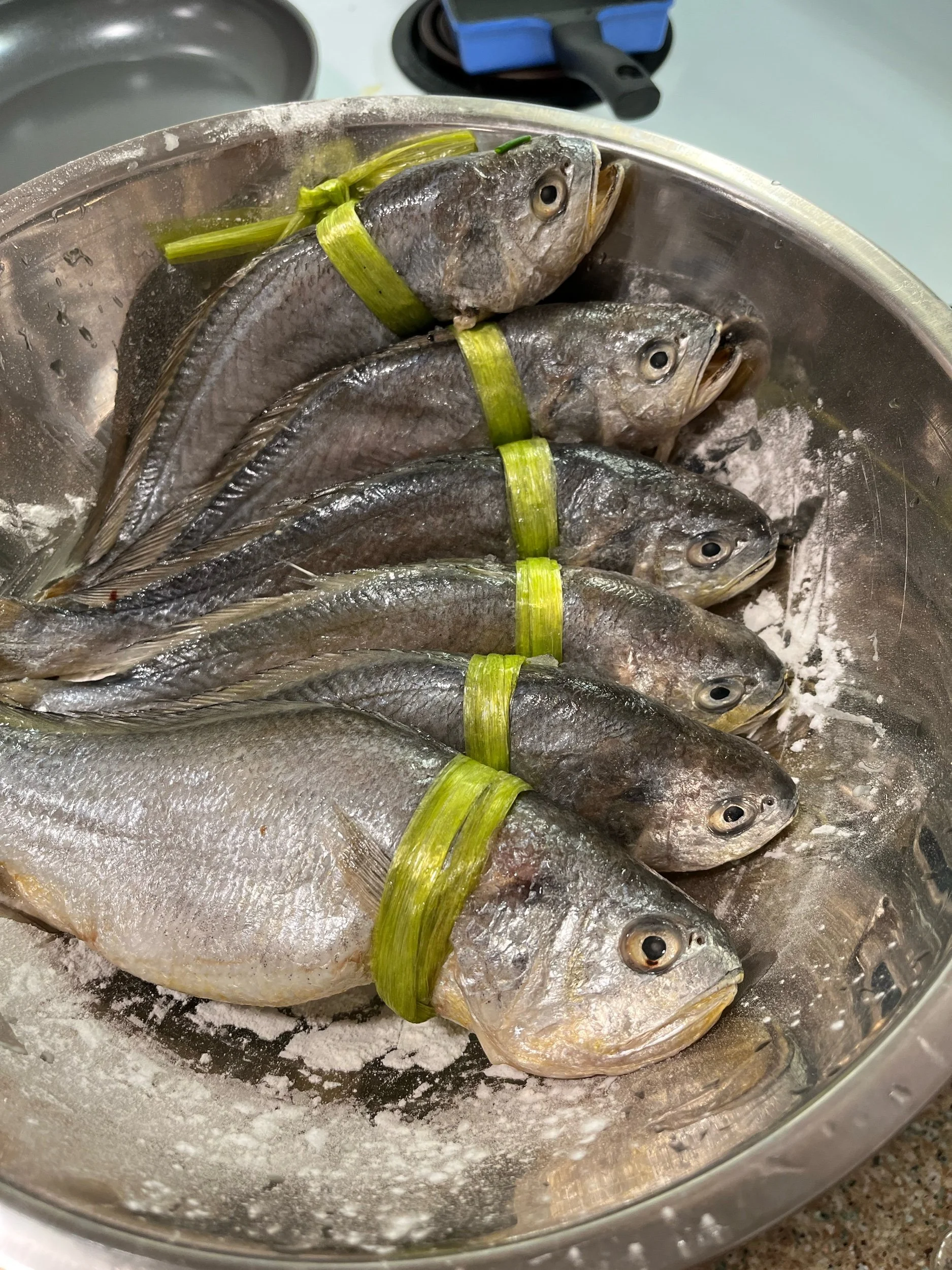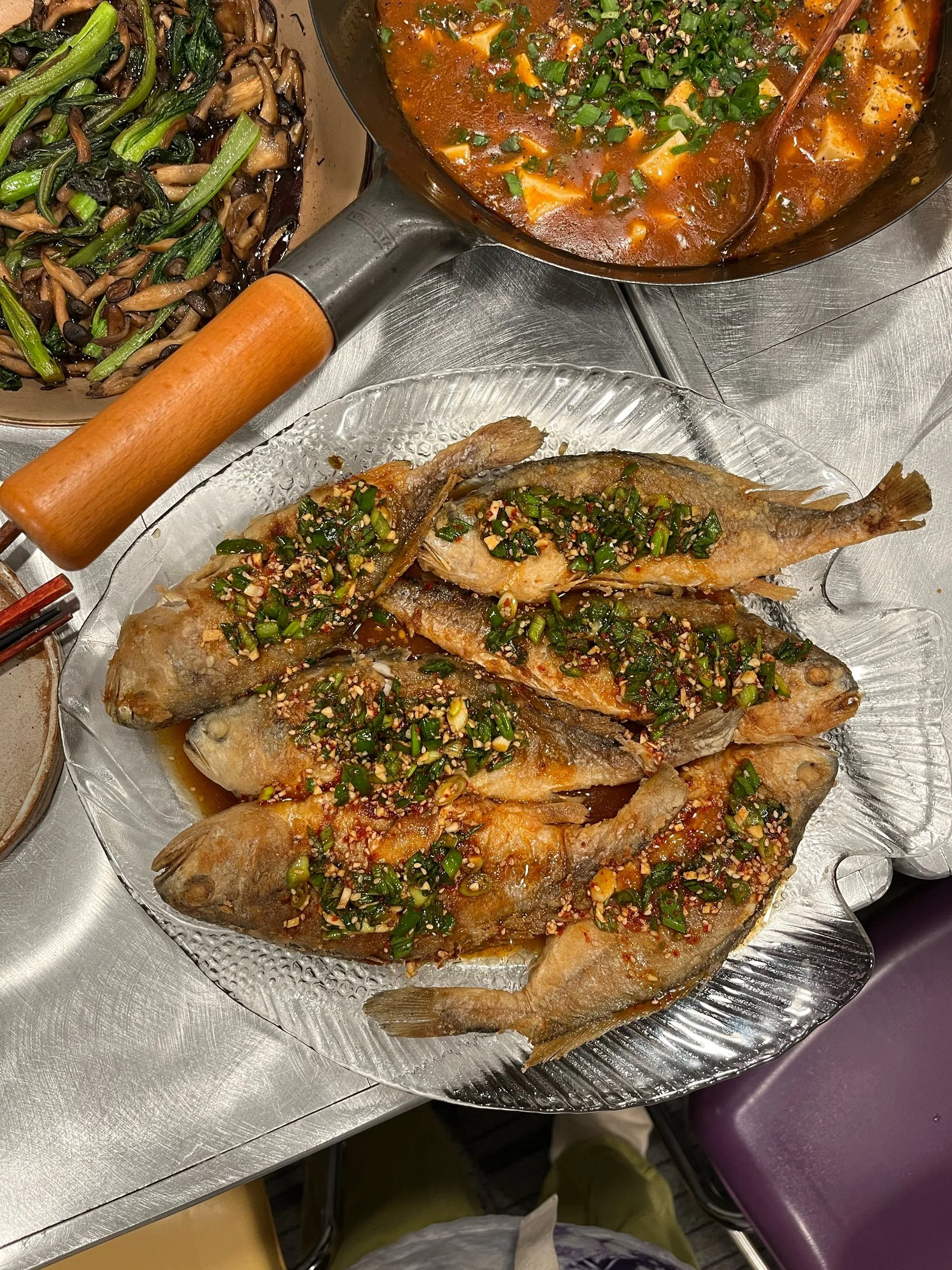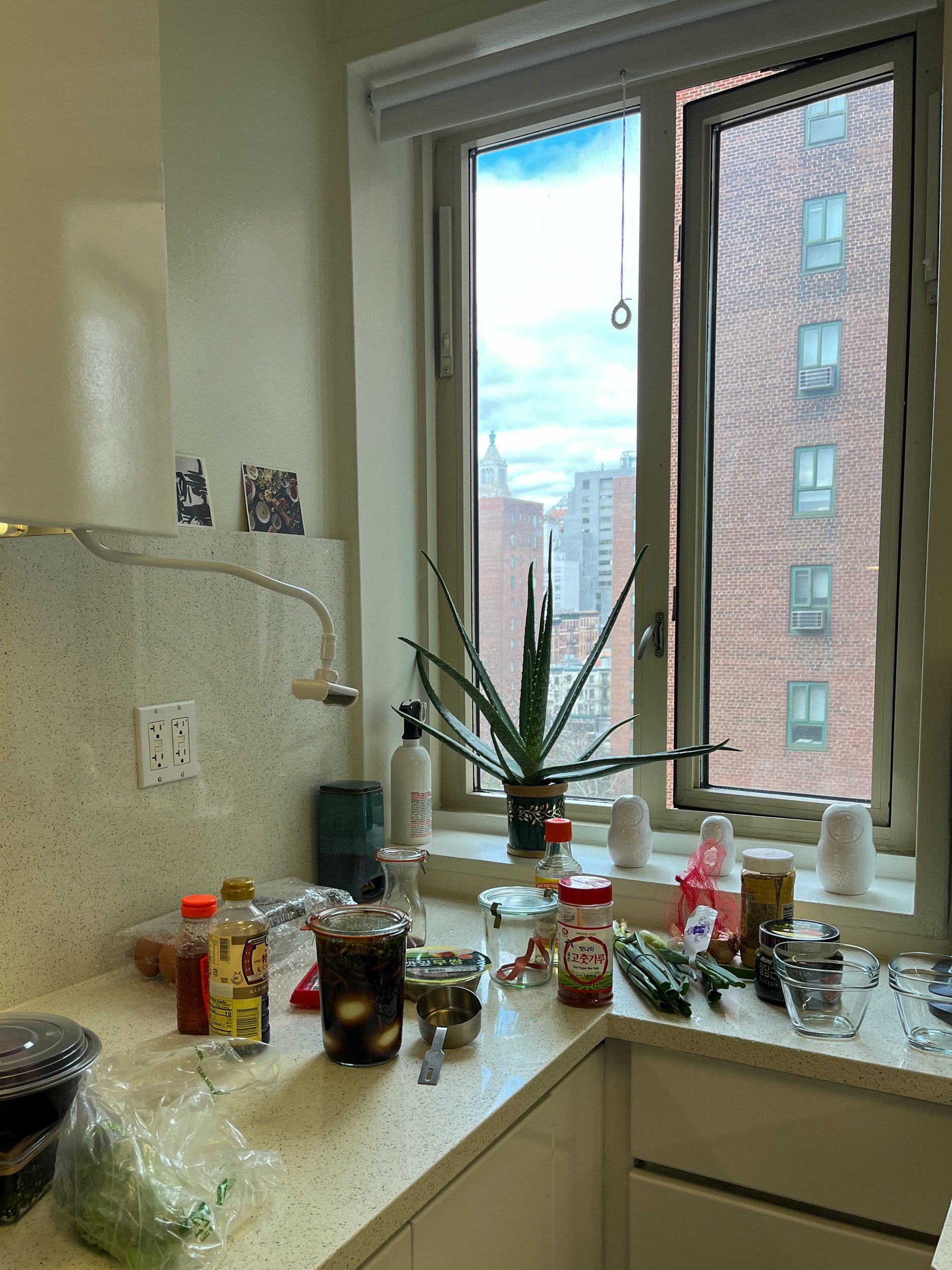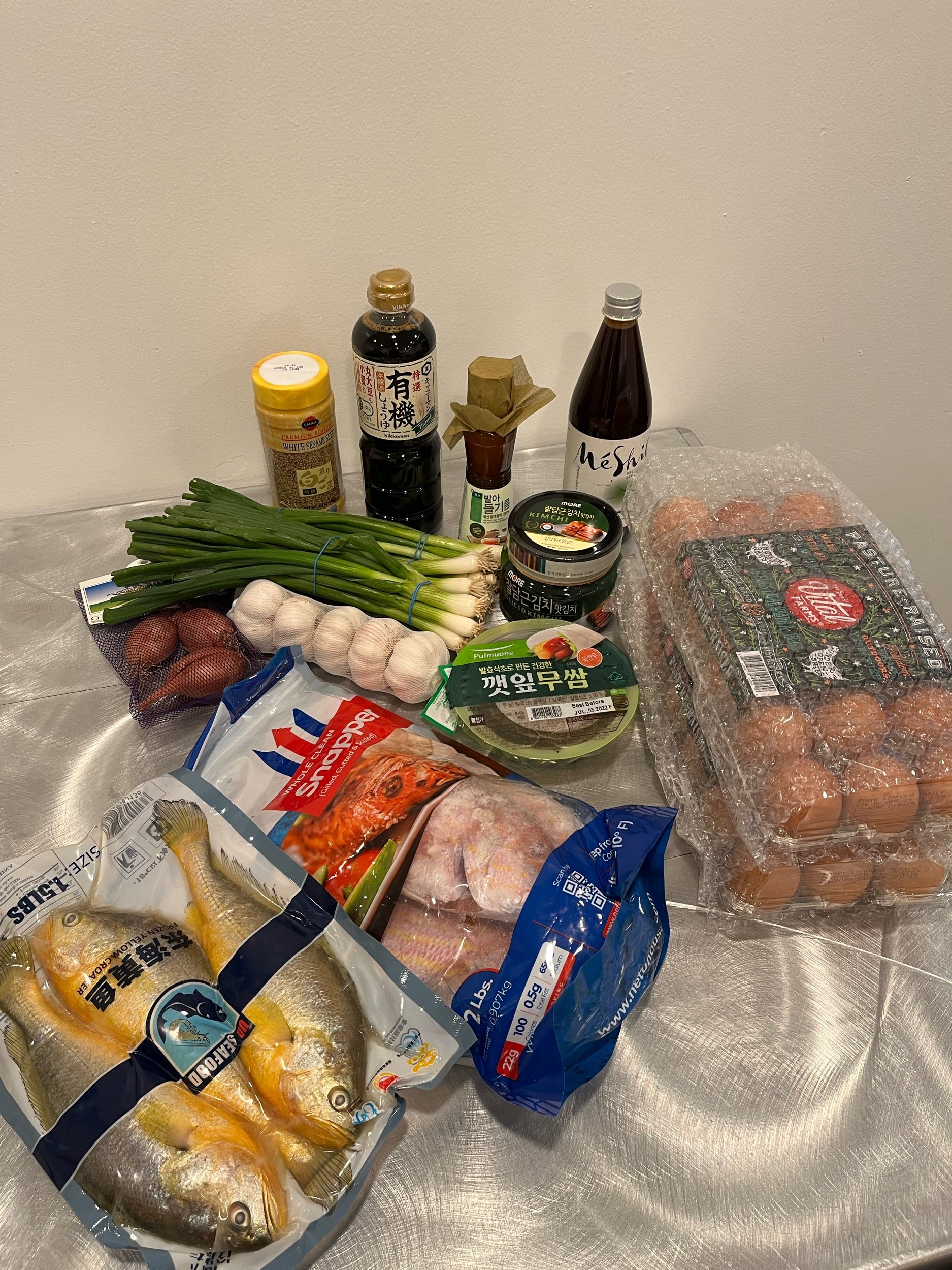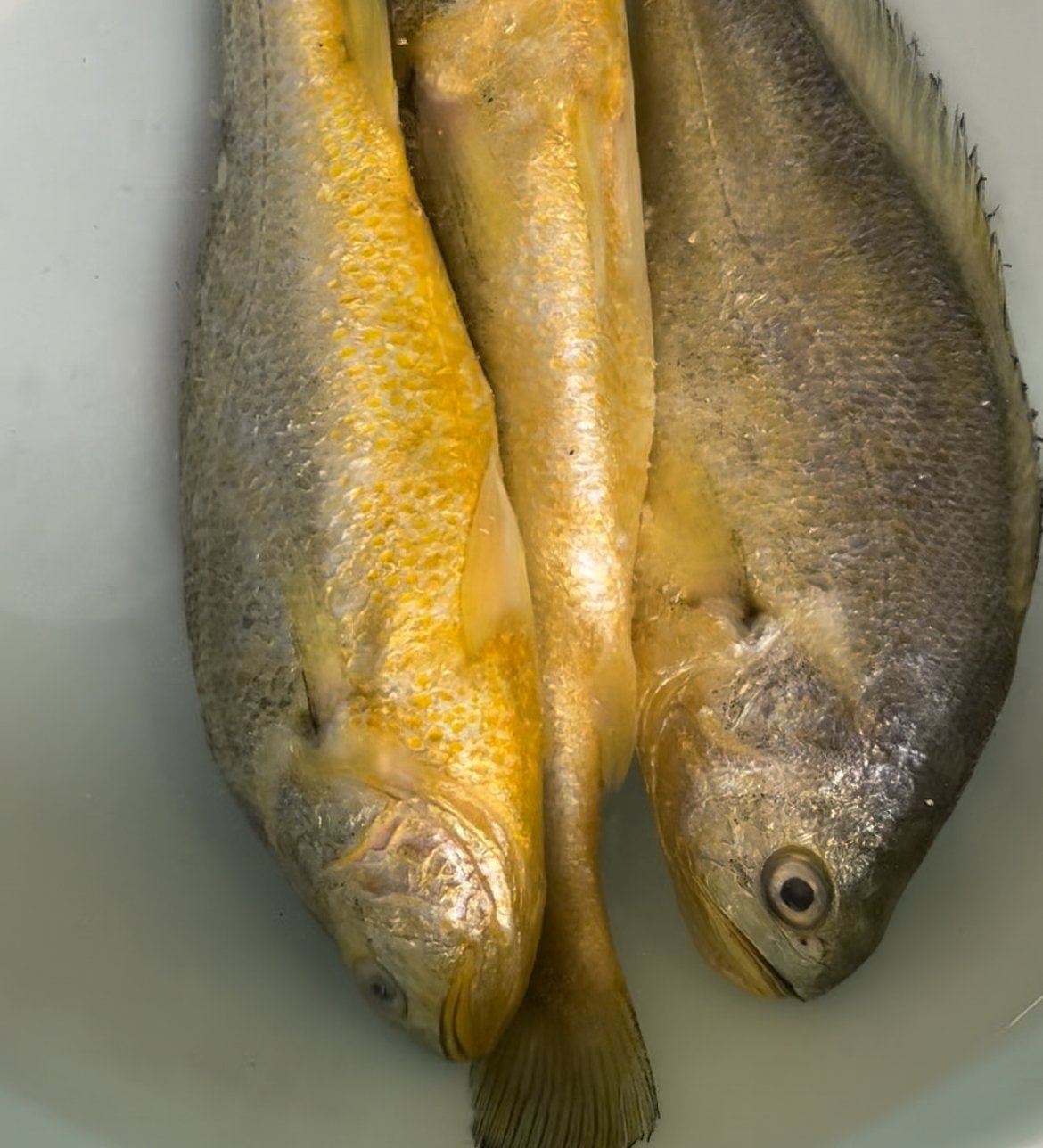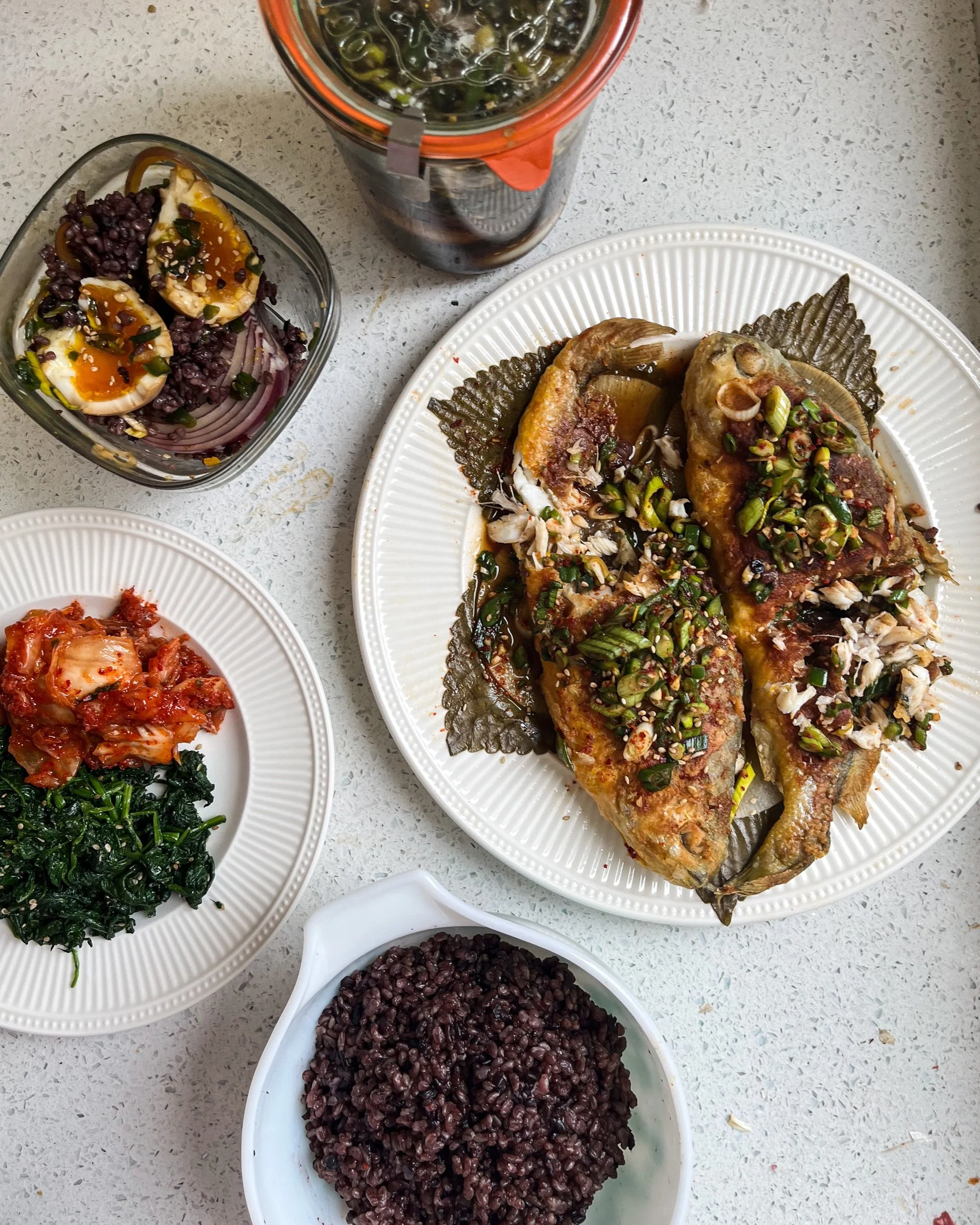korean fried whole fish
(saengsun gui // 생선 구이)
Want to cook along with me? Watch my step-by-step walkthrough on Mixo or watch a shorter trailer on IG .
From June 1 - 10, you can gain exclusive, early access to Mixo, a new, FREE Korean recipe video app made for cooks and creators. Use my referral code D5W0G6 when creating an account.
Active time: 35 minutes (Total: 1 hour 35 minutes)
Servings: 2-3 hot girls
fish ingredients:
1.5 lbs Korean salted yellow croaker/corvina, defrosted (or fresh red snapper, branzino, any mild, flaky white fish)
*to defrost fish: put frozen fish in bowl of water out at room temp 1 hour before cooking.
2 tbsp potato starch or cornstarch
2 tbsp flour
2 tbsp neutral oil (grapeseed, avocado, canola etc.)
sauce ingredients:
¼ cup soy sauce
1 tbsp rice wine vinegar
2 tbsp honey
2 tsp sesame oil
1 tbsp maesil // Korean plum extract (optional)
2 tbsp gochugaru (Korean red pepper flakes)
1 tbsp white sesame seeds
4 scallions, chopped
2 cloves garlic, finely diced
1 jalapeno or Korean green pepper, diced
1 tsp ginger
Recipe
1. Add all sauce ingredients in a small mixing bowl or jar. Mix well to dissolve the honey. (Alternatively, you could heat up the soy sauce in the microwave and dissolve the honey in the warm soy sauce, so the honey dissolves easier. But tbh I hate an extra step.)
2. Add 2 tbsp potato starch (or cornstarch ) and 2 tbsp all-purpose flour to a large bowl. If fish is unsalted, add a pinch of salt to the bowl. Coat fish in the mixture.
3. Heat 2 tbsp neutral oil (enough to coat pan) until glossy. Gently place fish in pan. Fry for 5 mins. Flip and fry the other side for 5 minutes. Then fry each side an additional 2 minutes. The fish should fry for a total of 14-15 minutes, or until golden brown. Remove from pan.
4. Pour sauce on top of fish. Voila— Saengseon Gui! Serve with rice and lettuce or perilla leaf wraps.
Non-negotiables
honey – honey is Korean sweetener of choice. I personally love raw honey because it has a more complex flavor.
gochugaru – If you don’t use Korean red pepper flakes, then the recipe isn’t Korean anymore.
Try experimenting with
whole fish – I tried a variety of different fish during recipe development. Yellow croaker, or yellow corvina, is the most commonly used Korean fried fish. (Perhaps you’ve tried it at the famous BCD Tofu House?) Yellow croaker come frozen, pre-cleaned, pre-salted, and dried. They are tied with a yellow rope and hung to dry as a preservation technique before they are frozen. You can find them in a box or bag in the frozen seafood section. Yellow croaker is pretty inexpensive; I can usually get 5-6 in a bag for less than $20. I also tried frozen red snapper in test #. Any mild, white, flaky whole fish will do.
In an attempt to make whole fish a part of casual eating, I find buying frozen whole fish more convenient for me. I can lay it out to defrost an hour in a bowl of water at room temp an hour before I want to eat. Buying fresh fish requires more forethought that personally stresses me out. Because then if I don’t get around to cooking the fish the day that I buy it, then I make myself anxious, trying to figure out when I am going to cook it…because I already have dinner plans for the next two days.
In test #4, however, I did buy with fresh branzino from my local fishmonger. I don’t know how to clean a whole fish, so I just ask the fishmonger to do it for me. (The fresh fish, yes, did taste better than frozen. It didn’t even need any salt because it was wild-caught.)
1 starch: 1 flour ratio – In recipe development, I used all starch, all flour, and a mixed ratio. They all work well. 100% starch burns the easiest. 1:1 ratio ensures the crispiest fish. What’s the food science? Starch has a higher starch:protein ratio than flour. During cooking, starch wards off water while protein holds onto water. If you only have one or the other though, it won’t significantly affect the recipe.
maesil -- Maesil is a pantry item in Korean cooking, used in marinades, sauces, tonics, and cold summer drinks. It is one of those items that is hard to find a substitute. I would list it as non-negotiable, but I know it is not the easiest to find or the cheapest pantry good. So, if you can’t find it, just eliminate it. It just adds a sweet tang. I would recommend trying it though since it is very versatile. I also call for it in Korean drug eggs.
extra sauce? – Use the marinade to braise tofu (dubu joirm), potatoes (gamja jorim), or black beans (kong jorim). In a pinch, you can also use the marinade for Korean drug eggs.
Food styling tips
Show me some skin — Scrape against the crispy skin with a utensil, so I can hear how crispy it is.
Get dressy — Get your phone ready before you dress the fish in sauce.
First bite — Document your bold plunge into the flaky, white flesh.
Recipe Development Notes
Test #1 – January 2022 – I celebrated Lunar New Year for the first time ever this year. For whatever reason, growing up in a Korean American household, I always celebrated the new year with my family on January 1st. I was taught “lunar new year” as solely “chinese new year.” I guess my family really said assimilate on that note 🤧 but through friends, I’ve come to learn that Lunar New Year is a shared celebration across the Asian diaspora.
Oddly enough, despite growing in Los Angeles, I never had a solid group of close Asian friends—a quintessential experience where many find community or what many have coined an Asian girl squad. My family has always joked that I’ve never had many Asian friends.
I have never felt like I was missing out…and it’s not like I select my friends based on race or ethnicity. This past year though, I have grown close to an incredible group of girls—all so gregarious, well-spoken, intelligent, and caring with shared values in bettering medicine. In the winter last year, one of my friends noticed that we all have short hair—in fact, we are the short haired Asian girls of our class. (You are not allowed to call us short hair Asian girls aloud though…this is our self-identification.) After 24 years of self-erasure, I’ve gained so much confidence in claiming my own heritage. After moving some 3000 miles away from home, I’ve found comfort through finding a community that shares a love language of cut fruit and warm rice.
I’m so grateful to have shared my first Lunar New Year with a new family away from home. For supper club that week, I cooked whole yellow croaker. Irvins sent me their salted yolk chips as PR, and so we experimented with crusting the fish with salted yolk chips and potato starch. The combination created a very crispy skin.
What I did right – Crispy crispy skin.
Needs improvement – I did not defrost the fish correctly. I just left it out for an hour or so in the bag (not in a bowl of water), so the flesh was slightly undercooked. It did not easily pull away from the bone.
Test #2 – February 2022 – I’m not sure how, but last year tinned fish became a part of my “brand.” (OK, I guess I did sell tinned fish ceramics, collaborate with the Glossier of tinned fish, publish a hot girl salad recipe, and document every time I was in the tinned fish aisle at specialty grocery store.) A year later, I love how people still tag me in photos of themselves checking out the tinned fish aisle and DM me tinned fish clothing or cartoons.
I still eat tinned fish once a week, and it has truly changed the way I can easily intake protein as a pescatarian. But this year, I want to expand the way I consume fish—that is, I want to cook whole fish.
Whole fish entertains the same sex appeal as tinned fish. They are both preserved in their whole form. The fish presents the way in the same way it was caught. As our food has become industrialized and processed, we have separated the raw from the cooked. We have internalized that raw food should look different than cooked. We don’t actually kill what we eat. We are not hunters anymore. But whole fish forces us to confront our origins.
Taking apart a whole fish is inherently destructive act. Sit in that discomfort. Then confront the fish before you. Admire its beauty for the last time. Be bold. Pull the first sardine dripping with EVOO out of the tin or break into crispy skin to reveal flaky white flesh.
TL;DR I cooked a whole fish for lunch just for myself on a Friday afternoon after class.
What I did right – I defrosted the fish in a bowl of water before going on a run. The fish was crispy on the outside and flaky in the inside.
Needs improvement – I actually used the marinade from Korean drug eggs. The marinade was a bit overwhelming. The fish needs a simpler sauce.
Test #3 – February 2022 – Mixo, a new Asian-founded, recipe-focused video creation app, approached me to join their Creator program before their official launch. Mixo was exclusively recruiting Korean creators to create Korean food recipes. I remember reading this e-mail after coming back from a run. My initial thoughts? What an interesting concept….will this model last solely on Korean food? Read more here on why I said YES to Mixo here.
I tested another whole fried fish for lunch.
What I did right – I used a tamer sauce with less alliums, allowing the fish to speak for itself.
Needs improvement – The sauce could use an extra tang.
Test #4 – March 2022 – I normally don’t buy fresh fish. It’s more expensive, and the fact that I have to use it in 48 hours stresses me out. But I wanted to make sure that fresh fish could also be used for the recipe. Mixo compensated all the ingredients for the recipe, so I went to my local fishmonger and bought 1.5 lbs branzino. My friend and I ran 10 miles earlier that day, training for our half marathon, and we devoured it all.
What I did right – Fresh fish was so much better than frozen. I actually forgot to salt the fish, but we agreed didn’t need salt at all.
Needs improvement – The sauce could still use an extra tang. I tried adding more rice wine vinegar but it made it more sour than tang.
Test #5 – April 2022 – I wanted to share the recipe with supper club the following week.
For much of my life, I’ve felt less than or not worthy of identifying as Korean. I wrote a short bit on this on Doof last June. So, I wasn’t sure if I could develop a Korean recipe myself. Yes, I’ve published the Banchan Bible—but I give almost all of that recipe credit to my grandmother. Those are her recipes. In the past, Korean food is the one part of Korean culture that I’m most familiar with—the part that makes me feel as though yes, I am more Korean American than any other ethnic identity. Cooking and sharing a lot of Korean food for my weekly supper club this past year has moved me to claim my Korean American identity more. While my friends make Szechuan or Japanese or Indonesian, etc. dishes for supper club, I’ll come with the Korean food.
What I did right – I scaled the recipe up, tripling the recipe and cooking for 8 people. I also added maesil (Korean plum extract). The fruitiness and slight fermented taste of the extract gave the sauce its needed tanginess.
Needs improvement – None! Ready to film.
Test #6 – April 2022 – I filmed both the whole fish and Korean drug eggs on the same day. It was exhausting. I can’t believe people to do this full-time. I’m not built for this life. This is why I should stay in school.
What I did right/Needs improvement – I flirt with my creative “could be’s”/”what-if’s”/”identities in the multiverse.” Yes, Everything Everywhere All At Once was a doozy for me. And then I bury myself back into known comforts of a more traditional, professional career track. Don’t worry, this is something I’m working through with my therapist.
If you decide to test this fish, please tag me @everythingalexcooks,
(and I mean actually tag me, the new IG update doesn’t notify me when I simply get mentioned in a caption).
I want to see your creations and hear your thoughts!





